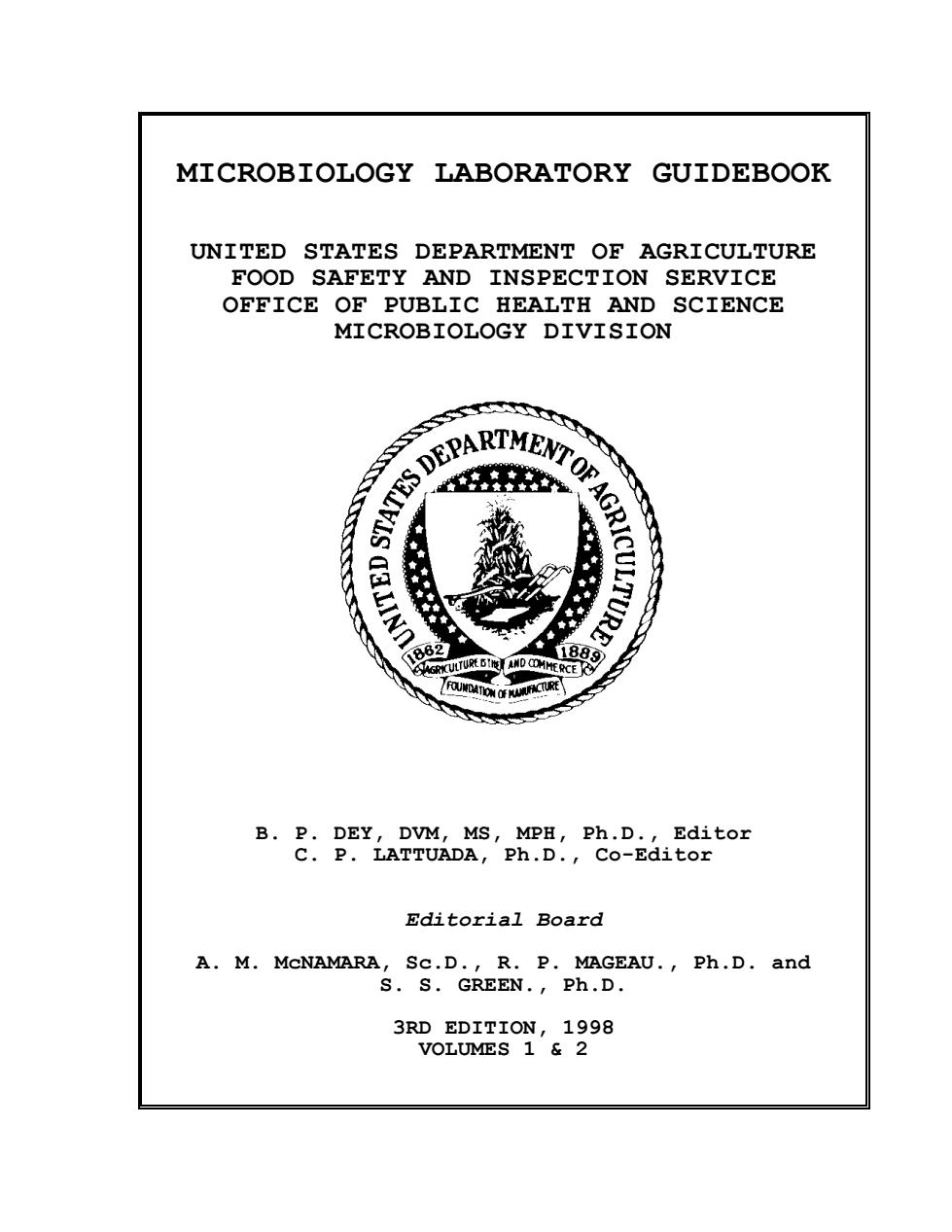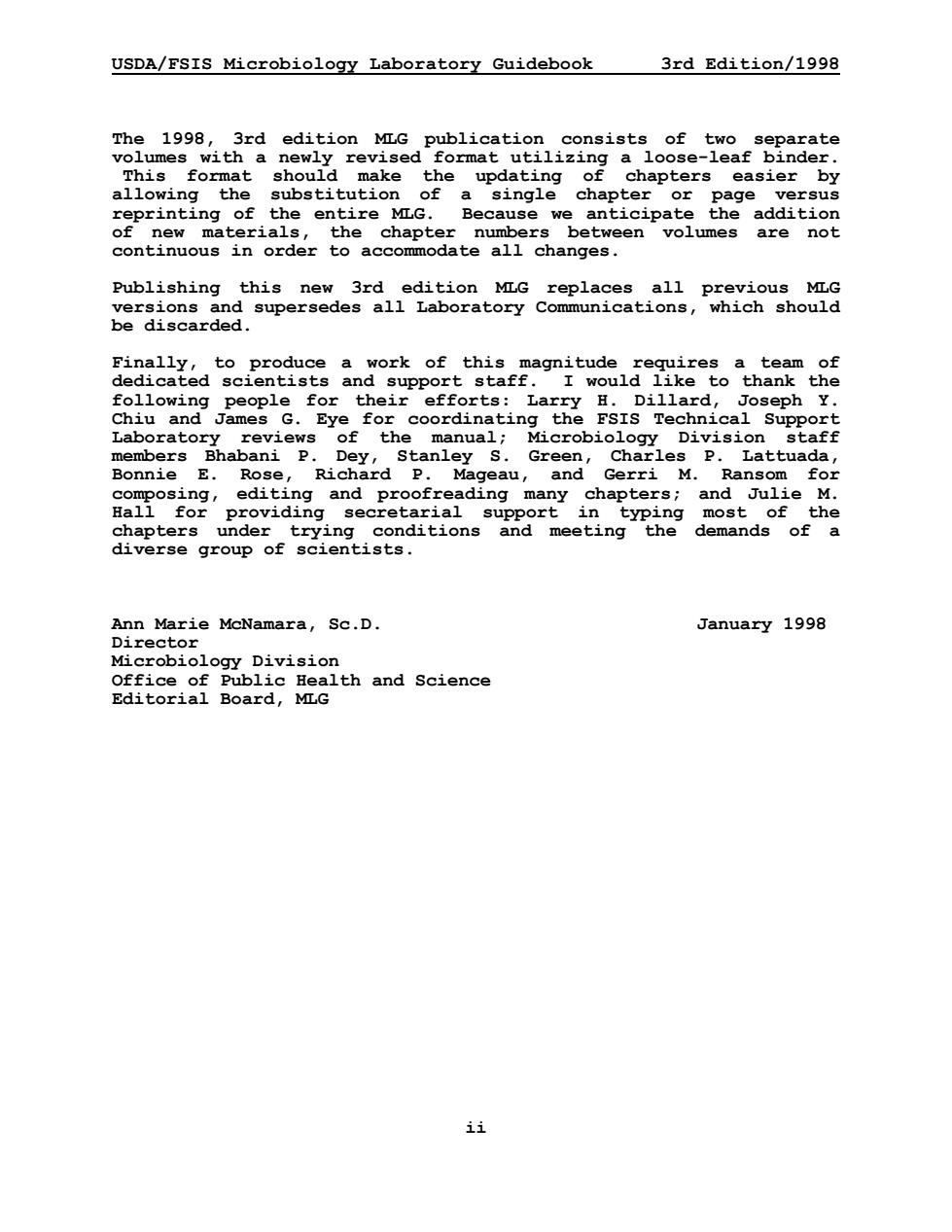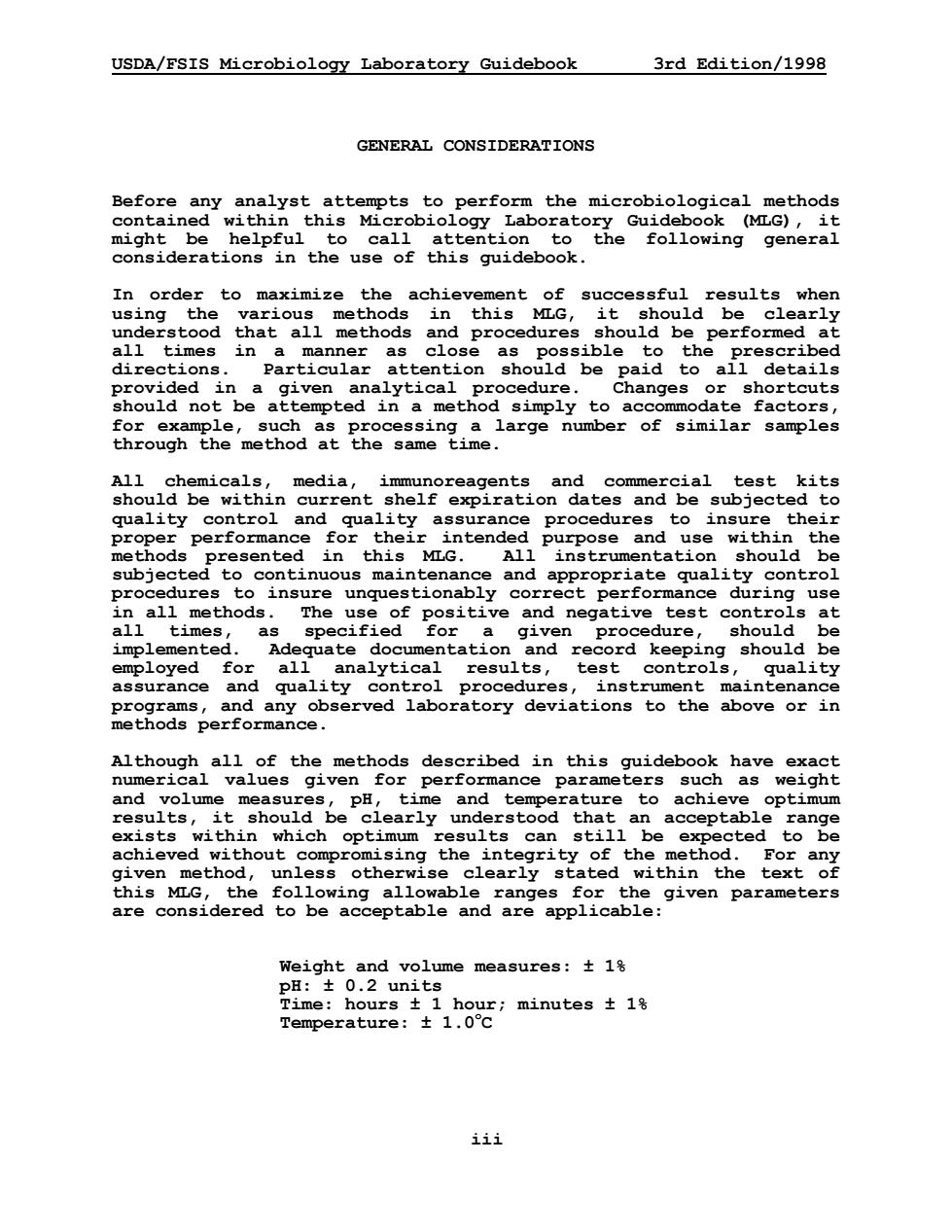
MICROBIOLOGY LABORATORY GUIDEBOOK UNITED STATES DEPARTMENT OF AGRICULTURE FOOD SAFETY AND INSPECTION SERVICE OFFICE OF PUBLIC HEALTH AND SCIENCE MICROBIOLOGY DIVISION AGRI CULTURE 82 MS, Editorial Board A.M.MCNAMARA,Sc.D.,R.P.MAGEAU.,Ph.D.and S.S.GREEN.,Ph.D. 3RD EDITION,1998 VOLUMES 1 2
MICROBIOLOGY LABORATORY GUIDEBOOK UNITED STATES DEPARTMENT OF AGRICULTURE FOOD SAFETY AND INSPECTION SERVICE OFFICE OF PUBLIC HEALTH AND SCIENCE MICROBIOLOGY DIVISION B. P. DEY, DVM, MS, MPH, Ph.D., Editor C. P. LATTUADA, Ph.D., Co-Editor Editorial Board A. M. McNAMARA, Sc.D., R. P. MAGEAU., Ph.D. and S. S. GREEN., Ph.D. 3RD EDITION, 1998 VOLUMES 1 & 2

USDA/FSIS Microbiology Laboratory Guidebook 3rd Edition/1998 FOREWORD ts the Microbiolo Division,Office of Public Health and Science,Food 8afa比and Inspection Service, United States ent +hg and updating Laborato for publication. This MLG is guidebook for the the Juiedction of USDA it contains methods that s prefers to use for the analysis of these foods. Since USDA does not endorse or approve as tor use。by the 1n 1 of anner. gimi1a1、 the n of specific brand for a product,medium,chemical or reagent associated with methods cts The use of the MLG comes with several caveats. This guidebook was logists,and personal that may pcour to individuals or orgsnizatiorause of the use of methods contained in this guidebook. Users should note and pay part icular attent on afety caution sym (t) and biological materials used in me of the methods】 Users must act in a responsible manner at all times to protect themselves and the environment during rmance these methods This guidebook must ell as 、1 hazards mana ment programs in order to operate a microbiolog laboratory. These programs are beyond the scope of this guidebook the sole responsibility of the user to develop and This guidebook contains protocols for analytical tests that are required by FSIS regulatory activities Some protocols,such as the tBioassay proc ure detect ar rcialize them. They are included here primarily as informational material since they are part of our current analytical methods
USDA/FSIS Microbiology Laboratory Guidebook 3rd Edition/1998 i FOREWORD The 1993 Escherichia coli O157:H7 outbreak in the Pacific Northwest focused national attention on food safety. Since then, the number of requests for reprints on analytical methods used by the Microbiology Division, Office of Public Health and Science, Food Safety and Inspection Service, United States Department of Agriculture, has increased dramatically. Scientists within the Division have responded to these requests by completely revising and updating our Microbiology Laboratory Guidebook (MLG) for publication. This MLG is our laboratory guidebook for the microbiological analysis of meat, poultry, and egg products that fall under the jurisdiction of USDA. It contains methods that FSIS prefers to use for the analysis of these foods. Since USDA does not endorse or approve methods for use by the food industry, inclusion of a particular method in the MLG should not be construed in this manner. Similarly, the mention of specific brand or trade names for a product, medium, chemical or reagent associated with methods contained herein does not constitute endorsement or selectivity by the authors or USDA over similar products that might also be suitable. The use of the MLG comes with several caveats. This guidebook was written for microbiologists, and its interpretation and use should only be undertaken by trained microbiologists. FSIS assumes no responsibility for any economic, personal injury or other damage that may occur to individuals or organizations because of the use of methods contained in this guidebook. Users should note and pay particular attention to the safety caution symbol (†) and written warnings associated with certain hazardous chemicals or dangerous biological materials used in some of the methods. Users must act in a responsible manner at all times to protect themselves and the environment during performance of these methods. This guidebook must be supplemented with quality assurance and quality control programs as well as chemical, biological, and employee safety hazards management programs in order to operate a microbiology laboratory. These programs are beyond the scope of this guidebook and are the sole responsibility of the user to develop and implement. This guidebook contains protocols for analytical tests that are required by FSIS regulatory activities. Some protocols, such as the Bioassay procedure for antibiotic residue detection and quantitation, may not be of value to commercial laboratories nor do we expect others to try to commercialize them. They are included here primarily as informational material since they are part of our current analytical methods

USDA/FSIS Microbiology Laboratory Guidebook 3rd Edition/1998 The 1998,3rd edition MLG publication consists of two separate volumes with a newly revised format utilizing a loose-leaf binder. for the should the upaat ng of chapters easier by of the entire ate the addition the chapter numbers between volumes are not continuous in order to accommodate all changes. pb】iahi 11 versions and supersedes all Laboratory Communications, Pwhich should be discarded」 of thi following Dillard,Joseph y. Chiu and James G.Eye for coordinating the FSIs Technical Support Laboratory re anua Bonnie E Rose.Richard P Mageau Grand'.Ransomfor of January 1998 Microbiology Division office of Public Health and Science Editorial Board,MLG ii
USDA/FSIS Microbiology Laboratory Guidebook 3rd Edition/1998 ii The 1998, 3rd edition MLG publication consists of two separate volumes with a newly revised format utilizing a loose-leaf binder. This format should make the updating of chapters easier by allowing the substitution of a single chapter or page versus reprinting of the entire MLG. Because we anticipate the addition of new materials, the chapter numbers between volumes are not continuous in order to accommodate all changes. Publishing this new 3rd edition MLG replaces all previous MLG versions and supersedes all Laboratory Communications, which should be discarded. Finally, to produce a work of this magnitude requires a team of dedicated scientists and support staff. I would like to thank the following people for their efforts: Larry H. Dillard, Joseph Y. Chiu and James G. Eye for coordinating the FSIS Technical Support Laboratory reviews of the manual; Microbiology Division staff members Bhabani P. Dey, Stanley S. Green, Charles P. Lattuada, Bonnie E. Rose, Richard P. Mageau, and Gerri M. Ransom for composing, editing and proofreading many chapters; and Julie M. Hall for providing secretarial support in typing most of the chapters under trying conditions and meeting the demands of a diverse group of scientists. Ann Marie McNamara, Sc.D. January 1998 Director Microbiology Division Office of Public Health and Science Editorial Board, MLG

USDA/FSIS Microbiology Laboratory Guidebook 3rd Edition/1998 GENERAL CONSIDERATIONS e5Einewaenzethatweobio8e the microbiological methods Laboratory Guidebook (MLG),it might be helpful to call attention to the following general considerations in the use of this guidebook In order to maximize the achievement of successful results when using the various methods in this MLG,it should be clearly uinderstood that all methods d pocedshould be performed a obe8ineacto 1。 provided in a given analytical rocedure should not be attempted in a method simply to accommodate factors, All chemicals, media, immunoreagents and commercial test kits should be within current shelf expiration dates and be subjected to quality control and quality assurance e procedures to insure esented in this A17 subjected to continuous maintenance and appropriate quality control dures to insure unquestionably correct performance during use ve an negative a implemented Ade uate documentation and record keeping should be employed for analytical results, test controls, assurance and qua .ty co procedures any oserved oratory deviations to the Although a11 of the methods described in this guidebook have exact er1 va. es for para as we gn d it should be Pelearly understood that ac exists within which optimum results can still achieved without compror the integrity of For any e。11 11 seble are considered to be ac eptable and are Pplicable: given pa ters Weight ime:hours士1hour;minutes±1号 Temperature:±1.0c iii
USDA/FSIS Microbiology Laboratory Guidebook 3rd Edition/1998 iii GENERAL CONSIDERATIONS Before any analyst attempts to perform the microbiological methods contained within this Microbiology Laboratory Guidebook (MLG), it might be helpful to call attention to the following general considerations in the use of this guidebook. In order to maximize the achievement of successful results when using the various methods in this MLG, it should be clearly understood that all methods and procedures should be performed at all times in a manner as close as possible to the prescribed directions. Particular attention should be paid to all details provided in a given analytical procedure. Changes or shortcuts should not be attempted in a method simply to accommodate factors, for example, such as processing a large number of similar samples through the method at the same time. All chemicals, media, immunoreagents and commercial test kits should be within current shelf expiration dates and be subjected to quality control and quality assurance procedures to insure their proper performance for their intended purpose and use within the methods presented in this MLG. All instrumentation should be subjected to continuous maintenance and appropriate quality control procedures to insure unquestionably correct performance during use in all methods. The use of positive and negative test controls at all times, as specified for a given procedure, should be implemented. Adequate documentation and record keeping should be employed for all analytical results, test controls, quality assurance and quality control procedures, instrument maintenance programs, and any observed laboratory deviations to the above or in methods performance. Although all of the methods described in this guidebook have exact numerical values given for performance parameters such as weight and volume measures, pH, time and temperature to achieve optimum results, it should be clearly understood that an acceptable range exists within which optimum results can still be expected to be achieved without compromising the integrity of the method. For any given method, unless otherwise clearly stated within the text of this MLG, the following allowable ranges for the given parameters are considered to be acceptable and are applicable: Weight and volume measures: ± 1% pH: ± 0.2 units Time: hours ± 1 hour; minutes ± 1% Temperature: ± 1.0o C

MICROBIOLOGY LABORATORY GUIDEBOOK UNITED STATES DEPARTMENT OF AGRICULTURE FOOD SAFETY AND INSPECTION SERVICE OFFICE OF PUBLIC HEALTH AND SCIENCE MICROBIOLOGY DIVISION AGRI CULTURE 82 188 MS, Editorial Board A.M.MCNAMARA,Sc.D.,R.P.MAGEAU.,Ph.D.and S.S.GREEN.,Ph.D. 3RD EDITION,1998 VOLUMES 1 2
MICROBIOLOGY LABORATORY GUIDEBOOK UNITED STATES DEPARTMENT OF AGRICULTURE FOOD SAFETY AND INSPECTION SERVICE OFFICE OF PUBLIC HEALTH AND SCIENCE MICROBIOLOGY DIVISION B. P. DEY, DVM, MS, MPH, Ph.D., Editor C. P. LATTUADA, Ph.D., Co-Editor Editorial Board A. M. McNAMARA, Sc.D., R. P. MAGEAU., Ph.D. and S. S. GREEN., Ph.D. 3RD EDITION, 1998 VOLUMES 1 & 2